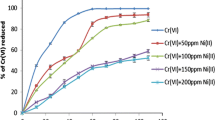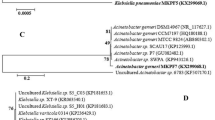Abstract
A hexavalent chromium [Cr(VI)] reducing bacterial strain was isolated from chromium-containing slag. It was identified as Pannonibacter phragmitetus based on physiological, biochemical characteristics and 16S rRNA gene sequence analysis. This bacterium displayed great Cr(VI) reduction capability. The Cr(VI) could be completely removed in 24 h under anaerobic condition when the initial concentration was 1,917 mg L−1, with the maximum reduction rate of 562.8 mg L−1 h−1. The Cr(VI) reduction rate increased with the increase of Cr(VI) concentration. P. phragmitetus was able to use many carbon sources such as lactose, fructose, glucose, pyruvate, citrate, formate, lactate, NADPH and NADH as electron donors, among which the lactate had the greatest power to promote the reduction process. Zn2+, Cd2+ and Ni2+ inhibited, while Cu2+, Pb2+, Mn2+ and Co2+ stimulated the reduction. The optimum pH and temperature for reduction were 9.0 and 30 °C, respectively. The results indicated that this strain had great potential for application in the bioremediation of chromate-polluted soil and water systems.






Similar content being viewed by others
References
Chai LY, Huang SH, Yang ZH, Peng B, Huang Y, Chen YH (2009) Cr(VI) remediation by indigenous bacteria in soils contaminated by chromium-containing slag. J Hazard Mater 167:516–522
Gupta VK, Rastogi A (2009) Biosorption of hexavalent chromium by raw and acid-treated green alga Oedogonium hatei from aqueous solutions. J Hazard Mater 163:396–402
Coata M (2003) Potential hazards of hexavalent chromate in our drinking water. Toxicol Appl Pharmacol 1:1–5
Garbisu C, Alkorta I, Llama Maria J, Serra JL (1998) Aerobic chromate reduction by Bacillus subtilis. Biodegradation 9:133–141
McLean J, Beveridge TJ (2001) Chromate reduction by a pseudomonad isolated from a site contaminated with chromated copper arsenate. Appl Environ Microbiol 67:1076–1084
Viti C, Pace A, Giovannetti L (2003) Characterization of Cr(VI)-resistant bacteria isolated from chromium-contaminated soil by tannery activity. Curr Microbiol 46:1–5
Puzon GJ, Roberts AG, Kramer DM, Xun L (2005) Formation of soluble organo-chromium(III) complexes after chromate reduction in the presence of cellular organics. Environ Sci Technol 39:2811–2817
Krishna RK, Philip L (2005) Bioremediation of Cr(VI) in contaminated soils. J Hazard Mater 20:109–117
Pei QH, Shahir S, Santhana Raj AS, Zakaria ZA, Ahmad WA (2009) Chromium(VI) resistance and removal by Acinetobacter haemolyticus. World J Microbiol Biotechnol 25:1085–1093
Srividya K, Mohanty K (2009) Biosorption of hexavalent chromium from aqueous solutions by Catla catla scales: equilibrium and kinetics studies. Chem Eng J 155:666–673
Cervantes C, Campos-García J (2007) Reduction and efflux of chromate by bacteria. Microbiol Monogr 6:407–419
Zhu WJ, Chai LY, Ma ZM, Wang YY, Xiao HJ, Zhao K (2008) Anaerobic reduction of hexavalent chromium by bacterial cells of Achromobacter sp. strain Ch1. Microbiol Res 163:616–623
Liu YG, Xu WH, Zeng GM, Li X, Gao H (2006) Cr(VI) reduction by Bacillus sp. isolated from chromium landfill. Process Biochem 41:1981–1986
Cheng GJ, Li XH (2009) Bioreduction of chromium(VI) by Bacillus sp. isolated from soils of iron mineral area. Eur J Soil Biol 45:483–487
Thacker U, Parikh R, Shouche Y, Madamwar D (2006) Hexavalent chromium reduction by Providencia sp. Process Biochem 41:1332–1337
Xu WY, Liu YG, Zeng GM, Li X, Song HX, Peng QQ (2009) Characterization of Cr(VI) resistance and reduction by Pseudomonas aeruginosa. Trans Nonferrous Met Soc China 19:1336–1341
Wani R, Kodam KM, Gawai KR, Dhakephalkar PK (2007) Chromate reduction by Burkholderia cepacia MCMB-821, isolated from the pristine habitat of alkaline crater lake. Appl Microbiol Biotechnol 75:627–632
Bae WC, Lee HK, Choe YC, Jahng DJ, Lee SH, Kim SJ, Lee JH, Jeong BC (2005) Purification and characterization of NADPH-dependent Cr(VI) reductase from Escherichia coli ATCC 33456. J Microbiol 43:21–27
Liu GF, Yang H, Wang J, Jin RF, Zhou JT, Lv H (2010) Enhanced chromate reduction by resting Escherichia coli cells in the presence of quinone redox mediators. Bioresour Technol 101:8127–8131
Polz MF, Cavanaugh CM (1998) Bias in template to product ratios in multitemplate PCR. Appl Environ Microbiol 64:3724–3730
Qian CR, Huang YX (2008) Laboratory experiments in microbiology. Beijing University press, Beijing
Pattanapipitpaisal P, Brown N, Macaskie L (2001) Chromate reduction and 16S rRNA identification of bacteria isolated from a Cr(VI) contaminated site. Appl Microbiol Biotechnol 57:257–261
Georgy GM, Julia BA, Timothy LG (2004) Bergery’s manual of systematic bacteriology. Springer, New York
Borsodi AK, Micsinai A, Kovács G, Tóth E, Schumann P, Kovács AL, Böddi B, Márialigeti K (2003) Pannonibacter phragmitetus gen. nov., sp. nov., a novel alkali-tolerant bacterium isolated from decomposing reed rhizomes in a Hungarian soda lake. Int J Syst Evol Microbiol 53:555–561
Wang PC, Mori T, Komori K, Sasatsu M, Toda K, Ohtake H (1989) Isolation and characterization of an Enterobacter cloacae strain that reduces hexavalent chromium under anaerobic conditions. Appl Environ Microbiol 55:1663–1670
Urvashi T, Datta M (2005) Reduction of toxic chromium and partial localization of chromium reductase activity in bacterial isolate DM1. World J Microb Biot 21:891–899
Shakoori AR, Makhdoom M, Haq RU (2000) Hexavalent chromium reduction by a dichromate-resistant gram-positive bacterium isolated from effluents of tanneries. Appl Microbiol Biotechnol 53:348–351
He ZG, Gao FL, Sha T, Hu YH, He C (2009) Isolation and characterization of a Cr(VI)-reduction Ochrobactrum sp. strain CSCr-3 from chromium landfill. J Hazard Mater 163:869–873
Poopal AC, Laxman RS (2009) Studies on biological reduction of chromate by Streptomyces griseus. J Hazard Mater 169:539–545
Sultan S, Hasnain S (2007) Reduction of toxic hexavalent chromium by Ochrobactrum intermedium strain SDCr-5 stimulated by heavy metals. Bioresour Technol 98:340–344
Shen H, Wang YT (1994) Biological reduction of chromium by E. coli. J Environ Eng 120:560–570
Xu L, Luo MF, Li WL, Wei XT, Xie K, Liu LJ, Jiang CY, Liu HZ (2011) Reduction of hexavalent chromium by Pannonibacter phragmitetus LSSE-09 stimulated with external electron donors under alkaline conditions. J Hazard Mater 185:1169–1176
Pal A, Paul AK (2004) Aerobic chromate reduction by chromium resistant bacteria isolated from serpentine soil. Microbiol Res 159:347–354
Abe F, Miura T, Nagahama T, Inoue A, Usami R, Horikoshi K (2001) Isolation of a highly copper-tolerant yeast, Cryptococcus sp., from the Japan trench and the induction of superoxide dismutase activity by Cu2+. Biotechnol Lett 23:2027–2034
Chai LY, Huang SH, Yang ZH, Peng B, Huang Y, Chen YH (2009) Hexavalent chromium reduction by Pannonibacter phragmitetus BB isolated from soil under chromium-containing slag heap. J Environ Sci Health A Tox Hazard Subst Environ Eng 44:615–622
Viamajala S, Smith WA, Sani RK, Apel WA, Petersen JN, Neal AL, Roberto F, Newby D, Peyton BM (2007) Isolation and characterization of Cr(VI) reducing Cellulomonas spp. from subsurface soils: implications for long-term chromate reduction. Bioresour Technol 98:612–622
Acknowledgments
This work was funded by the Major Program of Water Pollution Control and Treatment of China (2009zx07212-001-01) National Funds for Distinguished Young Scientists (50925417) and National Natural Science Foundation of China (51074191).
Author information
Authors and Affiliations
Corresponding author
Rights and permissions
About this article
Cite this article
Shi, Y., Chai, L., Yang, Z. et al. Identification and hexavalent chromium reduction characteristics of Pannonibacter phragmitetus . Bioprocess Biosyst Eng 35, 843–850 (2012). https://doi.org/10.1007/s00449-011-0668-y
Received:
Accepted:
Published:
Issue Date:
DOI: https://doi.org/10.1007/s00449-011-0668-y




